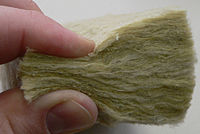
Photo from wikipedia
Mineral wool fibers can be released to the air during production and handling of a mineral wool product where a small fraction of fibers will stay airborne and can potentially… Click to show full abstract
Mineral wool fibers can be released to the air during production and handling of a mineral wool product where a small fraction of fibers will stay airborne and can potentially be inhaled. The aerodynamic fiber diameter determines how far an airborne fiber can pass through the human airway. Respirable fibers with an aerodynamic diameter < 3 µm can reach the deep part of the lungs (i.e., the alveolar region). Binder material (i.e., organic binder and mineral oil) is used in the production of mineral wool products. However, at the current stage it is unknown if airborne fibers can contain binder material. We explored binder presence on airborne respirable fiber fractions being released and collected during installation of two mineral wool products (a stone wool product and a glass wool product). Fiber collection was done by pumping a controlled air volume (2, 13, 22, and 32 l/min) through polycarbonate membrane filters during installation of the mineral wool products. Morphological and chemical composition of the fibers were studied using scanning electron microscopy coupled with energy dispersive X-ray spectroscopy (SEM-EDXS) analysis. The study demonstrates that binder material is found on the surface of the respirable mineral wool fiber mainly as circular or elongated droplets. Our findings suggest that respirable fibers explored in previous epidemiological studies, which have been used for proving lack of hazardous effects of mineral wool on humans, may have also contained binder materials on the fibers.
Journal Title: Journal of occupational and environmental hygiene
Year Published: 2023
Link to full text (if available)
Share on Social Media: Sign Up to like & get
recommendations!